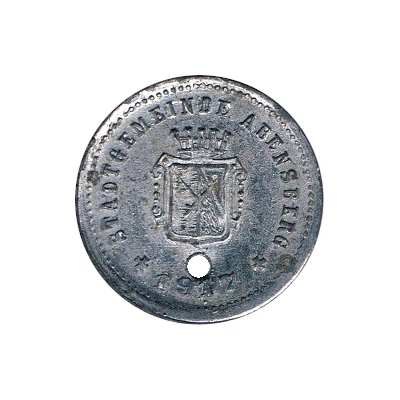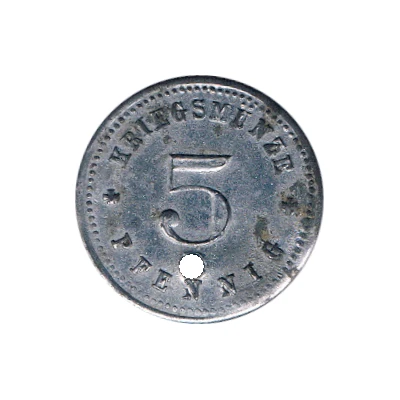


© oldandhardy
5 Pfennigs - Abensberg
1917 year| Zinc | 1.32 g | 19.8 mm |
| Issuer | City of Abensberg (Federal state of Bavaria) |
|---|---|
| Emperor | William II (Wilhelm II) (1888-1918) |
| Type | Standard circulation coin |
| Year | 1917 |
| Value | 5 Pfennigs (5 Pfennige) (0.05) |
| Currency | Mark (1914-1924) |
| Composition | Zinc |
| Weight | 1.32 g |
| Diameter | 19.8 mm |
| Thickness | 1 mm |
| Shape | Round with a round hole (Hole punched) |
| Technique | Milled |
| Orientation | Medal alignment ↑↑ |
| Demonetized | Yes |
| Updated | 2024-10-04 |
| Numista | N#238704 |
|---|---|
| Rarity index | 94% |
Reverse
Beaded rim, legend surrounding denomination centered
Script: Latin
Lettering:
KRIEGSMÜNZE
5
+ PFENNIG +
Edge
Plain
Interesting fact
The 5 Pfennigs - Abensberg 1917 coin was minted during a time of economic turmoil in Germany, known as the "Inflationary Period" (1914-1923). During this time, the value of the German mark (the national currency) plummeted, and prices for everyday goods skyrocketed. As a result, many Germans turned to alternative forms of currency, such as local emergency currencies like the 5 Pfennigs - Abensberg 1917 coin. This coin, made of zinc and weighing only 1.32 grams, was one of many emergency currencies issued by cities and towns across Germany to help alleviate the economic crisis. Despite its humble appearance, this coin is a fascinating piece of history that highlights the resourcefulness and resilience of the German people during a time of great economic uncertainty.